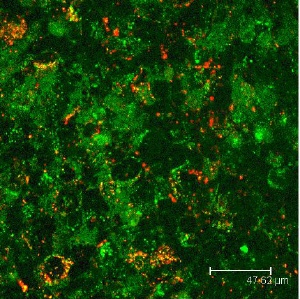Jul 17 2008
A unique nanoparticle system developed by University at Buffalo scientists takes advantage of the versatility of bioconjugated quantum rods to ferry novel diagnostic and therapeutic agents across the blood-brain barrier, according to recent in vitro findings.
 This confocal microscope image of a blood-brain barrier model shows quantum rods bioconjugated with transferrin; the findings could lead to better treatment of neuronal disorders.
This confocal microscope image of a blood-brain barrier model shows quantum rods bioconjugated with transferrin; the findings could lead to better treatment of neuronal disorders.
Described in a paper published in Bioconjugate Chemistry, the system uses the rod-shaped semiconductor nanoparticles that are bioconjugated, or coupled, with biomolecules capable of crossing the blood-brain barrier.
The blood-brain barrier acts as a physiological "checkpoint" that selectively allows certain molecules in blood circulation to enter the brain. While it naturally evolved in order to protect the brain from invasion of various circulating toxins and other harmful molecules, the blood-brain barrier also serves as a major impediment to the brain-specific delivery of various diagnostic/therapeutic molecules needed for combating various neuronal disorders.
The quantum rod system the UB researchers developed has the potential to simultaneously and non-invasively deliver diagnostic and therapeutic agents targeted to a wide variety of neurological diseases as well as obesity and drug addiction, according to Paras N. Prasad, Ph.D., executive director of the UB Institute for Lasers, Photonics and Biophotonics and SUNY Distinguished Professor in the Department of Chemistry, who led the UB team.
"These brain-specific nanoparticle systems represent a significant improvement over commonly used, highly-invasive methods of delivering active molecules into the brain, most of which rely on direct injection," he said.
The UB team, together with colleagues from Buffalo General Hospital, has developed a simple method for linking quantum rods to the iron-transporting protein, transferrin and other biomolecules, which routinely pass through the blood-brain barrier.
"Our findings unfold a new dimension in blood-brain barrier transport using inorganic nanoparticles, which are structurally robust and demonstrate the potential to transport multiple agents across this physiological barrier," said Indrajit Roy, Ph.D., deputy director for biophotonics at the UB institute. "This system allows the nanoparticles and the multiple therapeutic and imaging agents they carry to 'sneak' safely across the barrier and into the brain. It's a Trojan horse approach."
The functionalized quantum rods proved to have very low toxicity, according to Ken-Tye Yong, Ph.D., postdoctoral research associate in the UB institute, providing additional evidence that when linked to drug molecules, they could make very suitable treatment probes for diseases of the brain.
The new nanoparticle platform could provide scientists with a kind of window on the blood-brain barrier, enhancing what they know about it and allowing them to view non-invasively in real-time how imaging and therapeutic agents affect the brain.
The quantum rod system also serves as the basis of a blood-brain barrier-crossing test kit the UB researchers are developing.
The test kit would enable scientists to competitively evaluate which molecules would most efficiently transport diagnostic and therapeutic agents across the blood-brain barrier by exploiting the ability of quantum rods to emit light in different colors, depending on their size.
The research is closely aligned with the strategic strength in integrated nanostructured systems identified in the UB 2020 strategic planning process.
In addition to Prasad, Roy and Yong, co-authors included Gaixia Xu, Ph.D., former postdoctoral associate, and Hong Ding, Ph.D., postdoctoral associate, both of the UB Institute for Lasers, Photonics and Biophotonics; Supriya D. Mahajan, Ph.D., research assistant professor in the Department of Medicine in the UB School of Medicine and Biomedical Sciences and at Buffalo General Hospital, and Stanley A. Schwartz, M.D., Ph.D., UB professor of Medicine, Pediatrics and Microbiology and director of the Division of Allergy, Immunology and Rheumatology in the Department of Medicine at Buffalo General Hospital.
This research was supported by the John R. Oishei Foundation and by UB's New York State Center of Excellence in Bioinformatics and Life Sciences.
The University at Buffalo is a premier research-intensive public university, a flagship institution in the State University of New York system and its largest and most comprehensive campus. UB's more than 28,000 students pursue their academic interests through more than 300 undergraduate, graduate and professional degree programs. Founded in 1846, the University at Buffalo is a member of the Association of American Universities.